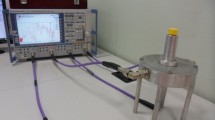Abstract
A novel readout procedure for a mercury sensor has been proposed. The sensor is based on the surface adsorption. Mercury vapor is adsorbed at the surface of a thin gold layer patterned into four meanders which are connected into a Wheatstone bridge configuration. Sensing is achieved by the resistivity change of the gold film during mercury adsorption. Direct output from the sensor is electric voltage. It takes an additional procedure to convert voltage to mercury concentration. This type of sensor is improved by introducing continuous readout procedure for the voltage–concentration conversion. By using this readout procedure it is possible to monitor mercury vapor concentration as a function of time. Readout is based on the Langmuir time–dependent adsorption theory. This paper illustrates a practical implementation of the new readout procedure.









Similar content being viewed by others
References
Bakshi AV, Bakshi UA (2007) Electronic measurements and instrumentation. Technical Publications, Pune
Brown RH (2000) Monitoring the ambient environment with diffusive samplers: theory and practical considerations. J Environ Monit 2:1–9
Butt HJ, Graf K, Kappl M (2006) Physics and chemistry of interfaces. Wiley, Berlin, pp 185–188
EPA, EPA’s Roadmap for Mercury (2006) http://www.epa.gov/mercury. Accessed 31 May 2012
EU, European Commission Directorate-General Environment Contract: ENV.G.2/ETU/2007/0021 (2008) Options for reducing mercury use in products and applications, and the fate of mercury already circulating in society Final Report
Langmuir I (1918) The adsorption of gases on plane surfaces of glass mica and platinum. J Am Chem Soc 40:1361
Mattoli V, Mazzolai B, Raffa V, Mondini A, Dario P (2007) Design of a new real-time dosimeter to monitor personal exposure to elemental gaseous mercury. Sens Actuators B 123:158–167
McNerney JJ, Buseck PR, Hanson RC (1972) Mercury detection by means of thin gold films. Sci New Ser 178(4061):611–612
Mercury Instruments USA, http://www.mercury-instrumentsusa.com/TrackerIP.htm. Accessed 31 May 2012
Pandey SK, Kim KH, Brown RJC (2011) Measurement techniques for mercury species in ambient air. Trends Anal Chem 30:899
Pirrone N, Cinnirella S, Feng X, Finkelman RB, Friedli HR, Leaner J, Mason R, Mukherjee AB, Stracher G, Streets DG, Telmer K (2009) Global mercury emissions to the atmosphere from natural and anthropogenic sources. In: Pirrone N, Mason R (eds) Mercury fate and transport in the global atmosphere. Springer, Dordrecht, Heidelberg, London, New York, pp 3–50
Schambach K, Eden K, Schumacher K, Wiegleb G (2002) Micromachined Mercury sensor. Proceedings of the 32th European solid-state device Research Conference (ESSDERC 2002) 24–26 September 2002 Firenze, Italy
Toda K, Ochi K, Sanemasa I (1996) NO-sensing properties of Au thin film. Sens Actuators B 32:15–18
Acknowledgments
This work was supported by the Ministry of Education and Science of Republic of Serbia, Contract No. TR 32008 of 2011.
Author information
Authors and Affiliations
Corresponding author
Rights and permissions
About this article
Cite this article
Sarajlić, M., Đurić, Z.G., Jović, V.B. et al. An adsorption-based mercury sensor with continuous readout. Microsyst Technol 19, 749–755 (2013). https://doi.org/10.1007/s00542-012-1679-6
Received:
Accepted:
Published:
Issue Date:
DOI: https://doi.org/10.1007/s00542-012-1679-6




